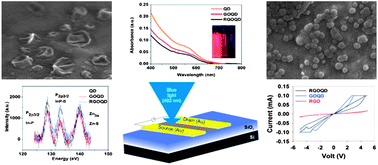InP/ZnS–graphene oxide and reduced graphene oxide nanocomposites as fascinating materials for potential optoelectronic applications†
Abstract
Our recent studies on metal–organic nanohybrids based on alkylated graphene

* Corresponding authors
a Department of Bionano Technology, GBRI, Gachon Bionano Institute, Gachon University, Seongnam 460-701, South Korea
b Department of Chemistry, Veer Surendra Sai University of Technology, Burla 768018, India
c Center for Biomaterials, Korea Institute of Science and Technology (KIST), Seoul 136-791, South Korea
d Advanced Photonics Research Institute (APRI), Gwangju Institute of Science and Technology (GIST), Gwangju 500-712, South Korea
e Samsung Advanced Institute of Technology, Yongin 446-712, South Korea
f SKKU Advanced Institute of NanoTechnology, Department of Mechanical Engineering, Sungkyunkwan University, Suwon 440-746, South Korea
g
Department of Chemistry, Myongji University, Yongin 449-728, South Korea
E-mail:
dongkeeyi@gmail.com
Our recent studies on metal–organic nanohybrids based on alkylated graphene

 Please wait while we load your content...
Something went wrong. Try again?
Please wait while we load your content...
Something went wrong. Try again?
M. Samal, P. Mohapatra, R. Subbiah, C. Lee, B. Anass, J. A. Kim, T. Kim and D. K. Yi, Nanoscale, 2013, 5, 9793 DOI: 10.1039/C3NR02333H
To request permission to reproduce material from this article, please go to the Copyright Clearance Center request page.
If you are an author contributing to an RSC publication, you do not need to request permission provided correct acknowledgement is given.
If you are the author of this article, you do not need to request permission to reproduce figures and diagrams provided correct acknowledgement is given. If you want to reproduce the whole article in a third-party publication (excluding your thesis/dissertation for which permission is not required) please go to the Copyright Clearance Center request page.
Read more about how to correctly acknowledge RSC content.
 Fetching data from CrossRef.
Fetching data from CrossRef.
This may take some time to load.
Loading related content
